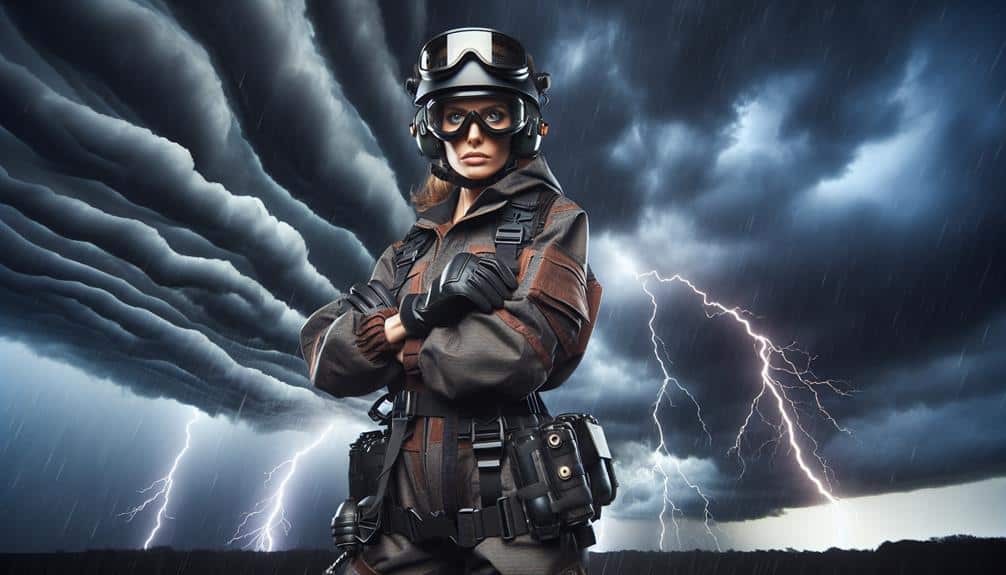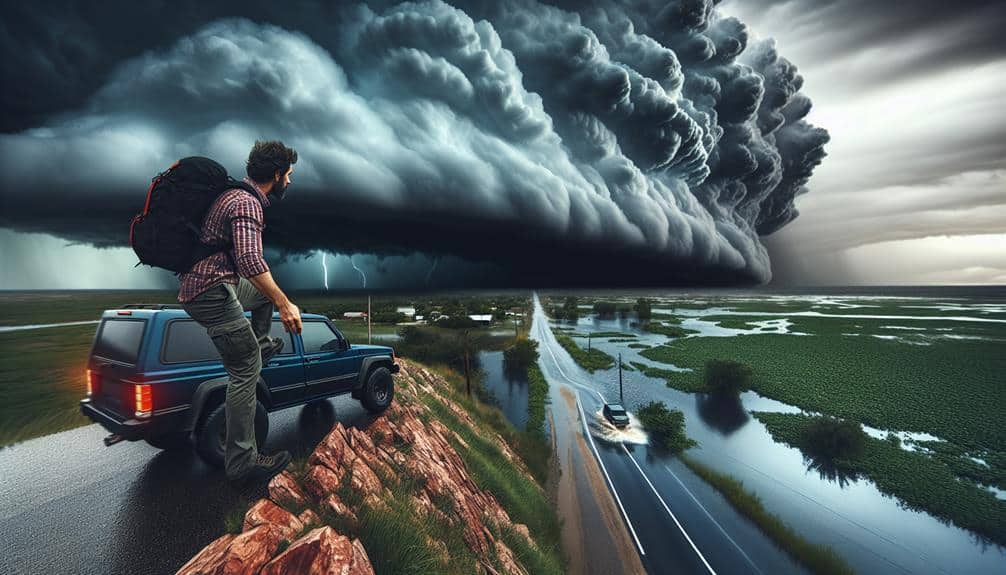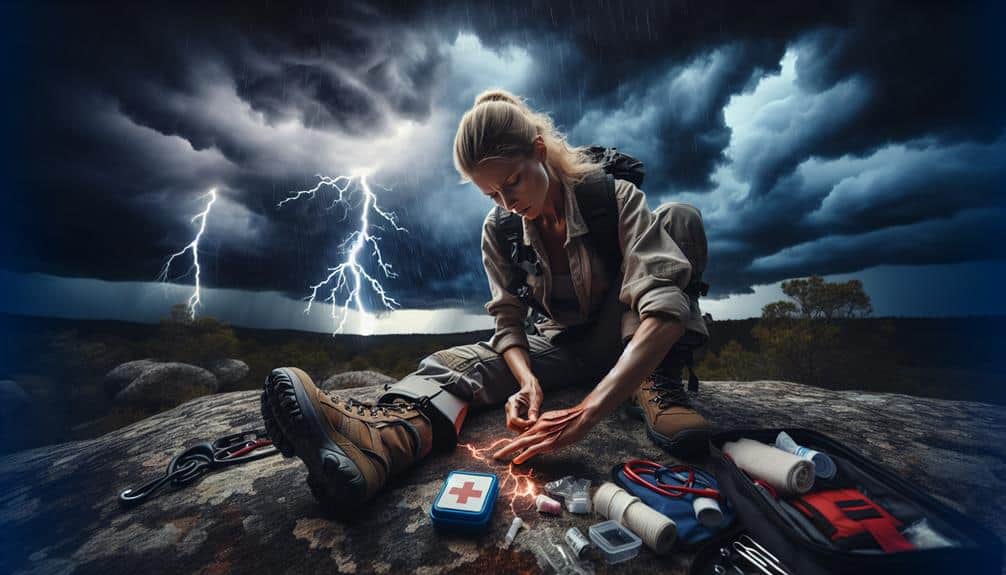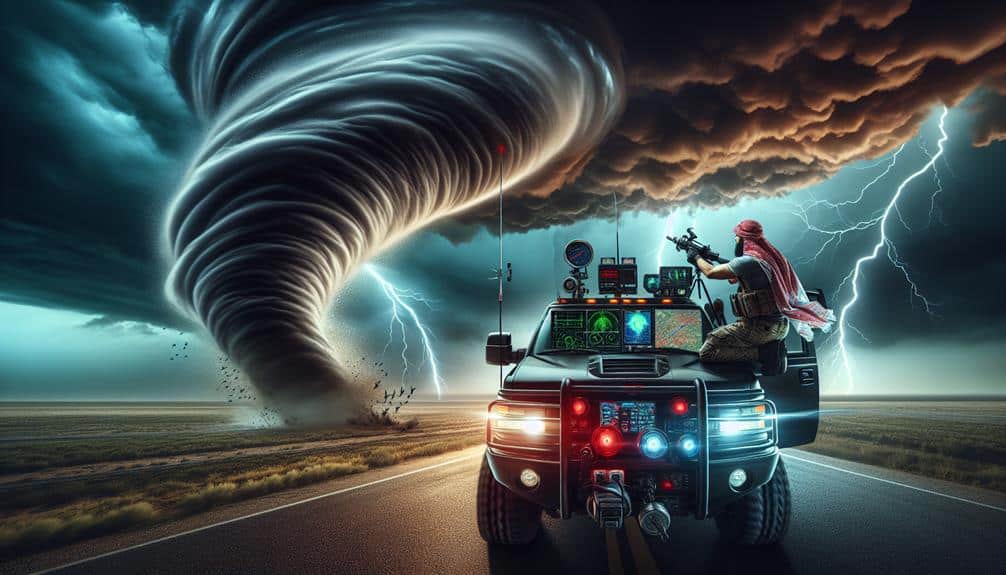When chasing storms, we must prioritize safety by monitoring real-time weather updates from reliable sources like the National Weather Service and using advanced tracking tools. We should equip ourselves with high-quality, well-maintained gear, including anemometers and protective clothing. Identifying and mapping escape routes and safe zones in advance is vital. Staying in constant communication through reliable channels like two-way radios and satellite phones is essential. Wear protective gear, avoid flood-prone areas, and carry emergency supplies. Knowledge of first aid basics and following expert advice further enhances our preparedness and safety. To uncover more essential practices, continue exploring this guide.
Key Points
- Consistently monitor real-time weather updates from reliable sources for informed decision-making.
- Equip with high-quality, well-maintained gear, including helmets, gloves, and waterproof clothing.
- Plan multiple exit routes and map safe zones for swift and secure evacuation.
- Use reliable communication devices like two-way radios and satellite phones for constant contact.
Monitor Weather Updates
To secure safety while storm chasing, we must consistently monitor real-time weather updates from reliable sources. By integrating advanced weather tracking technologies, we can enhance our safety precautions and make informed decisions.
Accessing up-to-the-minute forecast updates allows us to anticipate storm developments and modify our routes accordingly. This proactive approach helps mitigate risks and ensures we remain in control even as atmospheric conditions shift unpredictably.
Utilizing platforms such as the National Weather Service and specialized storm-chasing apps, we can obtain essential data on storm trajectories, wind speeds, and precipitation levels. These tools also provide timely alerts, enabling us to execute emergency response plans when necessary. By cross-referencing multiple sources, we reduce the likelihood of relying on inaccurate information, thereby increasing our situational awareness.
Additionally, we should establish a communication protocol with local emergency services. This ensures that, in the event of an unforeseen complication, we can quickly relay our location and receive assistance. Real-time coordination with emergency response teams is critical for maintaining safety during high-risk scenarios.
Use Reliable Equipment
Equipping ourselves with trustworthy gear is essential for guaranteeing safety and effectiveness during storm-chasing expeditions. We need to prioritize equipment maintenance and adhere to strict safety protocols to mitigate risks.
High-quality anemometers, barometers, and weather radios are pivotal for real-time data collection. These devices must be regularly calibrated and checked for any signs of wear and tear to ensure peak performance in the field.
Using reliable technology extends beyond just our primary tools. We should always have backup options in place. For instance, portable power banks and extra batteries are essential for keeping our devices operational during extended chases. Satellite phones and GPS units provide dependable communication and navigation, even when cellular networks fail. Ensuring these backups are charged and functional can make a significant difference in emergency situations.
Moreover, we must integrate safety protocols with our gear usage. This includes wearing protective clothing and helmets, and making sure our vehicles are equipped with emergency kits.
Plan Escape Routes
When planning escape routes, we must identify safe zones, map multiple exits, and constantly monitor weather updates. These steps guarantee that we can quickly and efficiently evacuate if conditions deteriorate.
Identify Safe Zones
How do we secure our safety during storm chasing? The key lies in identifying safe zones and planning effective escape routes. We need to pinpoint safe shelters that can withstand severe weather conditions, such as reinforced buildings or designated storm shelters. By incorporating emergency protocols, we guarantee that every team member knows exactly where to go and what to do when a storm intensifies.
Determining safe zones involves a thorough understanding of the area's topography and infrastructure. We must analyze maps and satellite imagery to identify potential shelters and safe zones. In rural areas, this might include sturdy farmhouses or community centers, while in urban settings, municipal buildings or underground parking structures could serve as safe havens.
Our strategy should include constant communication with local authorities and weather stations to stay informed about changing conditions. Portable weather radios and GPS devices are indispensable tools for real-time updates and navigation.
Effective planning and preparation aren't optional; they're essential for our safety. By identifying and utilizing safe zones, we can chase storms with the freedom we crave while minimizing risks. Let's make sure that our passion for storm chasing doesn't compromise our safety.
Map Multiple Exits
We must meticulously plan multiple exit paths to guarantee a swift and safe evacuation during unexpected storm developments. By identifying and mapping these paths in advance, we can make sure that we're ready for any sudden changes in weather conditions. It's essential to familiarize ourselves with the local road network, including both main highways and secondary roads, to avoid potential traffic bottlenecks or obstructions.
Our emergency procedures should include clear, detailed maps that highlight storm shelters along these paths. These shelters provide essential safety havens if evacuation becomes impossible. Each team member should carry a copy of these maps, both in digital and hardcopy formats, to cover any eventuality where communication networks might fail.
We need to regularly update and rehearse our escape plans, making certain that everyone knows the quickest and safest paths to safety. This practice can reduce hesitation and confusion during an actual emergency.
Additionally, we should be prepared to modify our paths in real-time based on current storm behavior and road conditions, remaining flexible and adaptive.
Monitor Weather Updates
Consistently monitoring weather updates allows us to make informed decisions and swiftly adjust our escape routes as conditions evolve. This proactive approach is essential in storm chasing, where weather can change rapidly and unpredictably.
Implementing advanced weather monitoring techniques and adhering to strict safety protocols guarantees our preparedness for any scenario.
To optimize our safety and efficiency, we must:
- Utilize real-time weather applications: These provide instant updates on storm movements and potential hazards.
- Deploy mobile weather stations: Portable equipment gives us thorough, on-the-ground data.
- Engage with local meteorological services: Access to localized forecasts and warnings can be pivotal.
Stay in Communication
To stay in communication, we must use reliable communication devices and establish regular check-in times.
We should also continuously monitor weather updates to guarantee we have the latest information.
These practices will enhance our ability to respond promptly to changing conditions.
Use Reliable Communication Devices
In the unpredictable world of storm chasing, having dependable communication devices guarantees we can coordinate effectively and respond swiftly to sudden weather changes. These devices are essential for maintaining real-time updates on weather tracking and transmitting emergency signals when necessary. We must prioritize equipment that guarantees uninterrupted communication, as our safety depends on it.
To maintain seamless communication, let's consider essential tools:
- Two-way radios: These provide reliable, direct communication with our team, even in areas with limited cellphone reception.
- Satellite phones: Offering global coverage, satellite phones ensure we remain connected when traditional networks fail.
- Weather alert radios: These devices deliver real-time updates on severe weather conditions, enabling us to make informed decisions quickly.
Establish Check-In Times
We should establish regular check-in times to confirm everyone remains informed and coordinated throughout the storm chasing expedition. By scheduling these check-ins, we can make certain all team members adhere to safety protocols and can respond swiftly to any changes in the situation. Communication is critical; we must utilize these intervals to confirm our locations, share observations, and discuss any immediate concerns.
Our primary mode of communication should be reliable but also supported by an emergency contact system. Each team member needs to have a designated emergency contact who's aware of our route and plans. In case of communication breakdown within the team, this contact can coordinate efforts to re-establish communication or initiate rescue operations.
We should also integrate these check-in times into our broader safety protocols. This includes verifying that all communication devices are fully operational before departure and after every critical phase of our chase. By doing so, we maintain a structured and secure environment, allowing us the freedom to focus on chasing while minimizing risks.
Regular check-ins aren't just procedural; they're essential for maintaining situational awareness and ensuring our collective safety. This proactive approach enables us to chase storms with confidence and preparedness.
Monitor Weather Updates
Alongside regular check-ins, staying updated with real-time weather information is vital for making informed decisions during our storm chasing activities. Accurate weather tracking enables us to anticipate changes and adapt swiftly, enhancing both our effectiveness and safety.
To optimize our preparedness planning, we must integrate various tools and strategies:
- Mobile Weather Apps: Utilize apps that offer real-time updates, radar imagery, and severe weather alerts.
- NOAA Weather Radio: This provides continuous broadcasts of weather information and important emergency communication.
- Satellite Communication Devices: These ensure connectivity in remote areas where cellular coverage is unavailable.
By leveraging these resources, we can establish robust safety protocols that mitigate risks. It's crucial to keep our communication lines open and make sure all team members are aware of the latest weather developments. This allows us to make informed decisions and reposition as necessary, maintaining our pursuit without compromising safety.
Effective emergency communication is vital during unexpected weather shifts. Our preparedness planning should include predefined responses to various scenarios, making sure we're ready to act promptly. By prioritizing real-time weather tracking and consistent updates, we enhance our ability to navigate the unpredictable nature of storm chasing with confidence and freedom.
Wear Protective Gear

Proper protective gear is necessary to guarantee our safety while storm chasing. We need to make sure our equipment is in top condition; hence, regular equipment maintenance is critical. By adhering to a stringent maintenance routine, we reduce the risk of gear failure during critical moments.
Our gear checklist should include items like helmets, sturdy boots, and gloves, all of which are essential for personal protection. Protective clothing is another important aspect. We should opt for waterproof, wind-resistant jackets and pants to shield us from the elements. Additionally, high-visibility vests enhance our visibility in low-light conditions, which is crucial during stormy weather. Each piece of our gear must meet safety standards to provide adequate protection.
In our emergency protocol, it's important to include immediate access to first-aid kits and communication devices. These tools enable us to respond swiftly to any unforeseen incidents. We must also verify that our protective gear isn't only available but also easily accessible at all times.
Understand Storm Patterns
To understand storm patterns, we must analyze weather data meticulously.
By identifying storm systems, we can better anticipate their development.
This allows us to predict storm movement accurately and enhance our safety measures.
Analyzing Weather Data
Storm chasers rely on analyzing weather data to understand storm patterns, enabling them to predict the storm's path and intensity with greater accuracy. By leveraging advanced data analysis, we can make informed decisions and maximize our chances of safely observing these natural phenomena. This process involves synthesizing large sets of meteorological data to identify key indicators of storm development and movement.
Utilizing various forecasting techniques, we enhance our storm tracking capabilities.
Key elements in our data analysis include:
- Radar imagery: Provides real-time information on precipitation, storm structure, and intensity.
- Satellite data: Offers a broader view, helping us track large-scale weather patterns and storm evolution.
- Surface observations: Includes data from weather stations on temperature, humidity, and wind speed, vital for understanding local conditions.
Identifying Storm Systems
Building on our analysis of weather data, we now focus on identifying storm systems by examining specific atmospheric patterns and indicators. Effective storm identification hinges on the recognition and analysis of key weather patterns. These patterns include wind shear, temperature gradients, humidity levels, and pressure systems. By pinpointing these elements, we can ascertain the likelihood of storm formation.
Our tracking techniques employ advanced radar imagery, satellite data, and ground-based observations. Radar helps us detect precipitation intensity and movement, while satellites provide broader views of cloud formations and atmospheric disturbances. Ground-based observations fill in gaps by offering real-time data on wind speed, pressure changes, and temperature shifts.
Weather pattern recognition is fundamental. For example, supercell thunderstorms are often identified by their distinctive hook echo on radar images, indicating potential tornado development. Similarly, squall lines, which can produce severe wind gusts and hail, appear as elongated bands of intense weather on radar scopes.
Predicting Storm Movement
Understanding storm movement involves analyzing various meteorological factors that influence the trajectory and speed of storm systems. To effectively engage in storm tracking and weather prediction, we need to take into account several vital elements. By doing so, we can make informed decisions that improve our safety and freedom while chasing storms.
- Wind Patterns: Monitoring wind direction and speed helps us predict where a storm might travel next.
- Pressure Systems: High and low-pressure areas greatly impact storm movement, directing their paths.
- Temperature Gradients: Variations in temperature between different air masses can determine storm intensity and trajectory.
By integrating these factors, we can achieve more precise weather prediction. For example, analyzing wind patterns provides insights into the storm's potential direction, while understanding pressure systems offers clues about its likely path. Combined with temperature gradients and humidity levels, we can forecast how quickly and where the storm will move.
Our approach to storm tracking must be thorough and data-driven. By utilizing advanced meteorological tools and real-time data, we enhance our ability to predict storm movements accurately. This accurate prediction is essential for maintaining our safety and ensuring we retain the freedom to chase storms responsibly.
Avoid Flood-Prone Areas

When planning our storm chasing routes, we must carefully identify and avoid areas prone to flooding. Flood-prone areas pose significant hazards, undermining both our safety and our ability to navigate effectively. To guarantee we remain unhindered by rising waters, we need to analyze topographical maps and weather forecasts that highlight flood risks. This analysis helps us understand the terrain and predict potential flood zones.
Being prepared for flood evacuation is essential. We should always have a detailed plan that includes multiple escape routes. Monitoring real-time weather updates and river levels can provide vital information for making timely decisions. Additionally, we should be aware of local flood history and specific areas known for rapid water accumulation.
Implementing safety precautions is non-negotiable. We must prioritize checking the condition of roads and bridges en route to avoid getting stranded. Flash floods can occur with little warning, so we should avoid low-lying areas, riverbanks, and regions with poor drainage systems. Using GPS systems with live traffic and weather updates can further assist in dynamically adjusting our path to steer clear of these hazards.
Keep Emergency Supplies
To make certain we're prepared for any situation, we must maintain a comprehensive emergency supply kit in our vehicle. Storm chasing demands preparedness for unforeseen circumstances, and having the right tools can mean the difference between safety and peril. Our emergency supply kit should be carefully curated to support us in various scenarios.
Essential components of our kit include:
- Emergency shelter: A portable, weather-resistant tent or tarp to shield us from harsh conditions.
- Survival kit: This includes items like a multi-tool, waterproof matches, and high-calorie food bars to sustain us if we're stranded.
- First aid supplies: Bandages, antiseptics, and emergency blankets for immediate medical needs.
Analyzing these items, we see each serves a critical role in our survival strategy. The emergency shelter provides immediate protection from elements, while the survival kit guarantees we've essentials to endure until help arrives. First aid supplies address urgent health concerns, and communication devices keep us informed and connected.
Know First Aid Basics

While our emergency supplies equip us for a range of scenarios, knowing basic first aid can greatly enhance our ability to handle injuries and medical emergencies during storm chasing. When we're out in the field, immediate medical assistance mightn't be readily available. Understanding how to administer first aid is essential for ensuring our safety and the safety of others.
We should start by learning essential first aid skills such as CPR, wound care, and how to treat shock. These are fundamental techniques that can stabilize a situation until professional help arrives.
Regularly practicing scenarios will help us respond swiftly and calmly during real emergencies. For instance, simulating a teammate's injury during a practice run allows us to refine our emergency response.
Moreover, knowledge of basic first aid can help us make informed decisions under pressure. Knowing when to move an injured person or when to wait for professional assistance can be life-saving.
We should also familiarize ourselves with the symptoms of common storm-chasing injuries, such as heat stroke, hypothermia, and fractures.
Follow Expert Advice
Consulting experienced storm chasers and meteorologists provides us with invaluable insights and strategies for maneuvering through severe weather safely. Their expertise in storm preparation and risk assessment is essential for minimizing dangers while maximizing our freedom to explore nature's most extreme conditions.
By adhering to established safety protocols and emergency response procedures, we can make sure our adventures are both thrilling and secure.
To benefit from their knowledge, we should focus on several key areas:
- Risk Assessment: Understanding the likelihood of severe weather conditions and their potential impact helps us make informed decisions.
- Safety Protocols: Implementing proven safety measures, such as maintaining a safe distance from storms and knowing evacuation routes, guarantees we stay out of harm's way.
- Emergency Response: Being equipped with first aid kits, communication devices, and knowing emergency contacts can make a significant difference during unexpected situations.
We can't afford to underestimate the value of expert advice. By integrating their guidance into our storm chasing routines, we enhance our capability to navigate and document severe weather events effectively.
Let's always prioritize safety by learning from those who've mastered the art and science of storm chasing.
Frequently Asked Questions
What Is the Best Time of Year for Storm Chasing?
The ideal seasons for storm chasing are spring and early summer due to increased storm activity. However, these periods carry significant risks. We should always follow safety tips and take necessary precautions to guarantee our safety.
How Can I Get Involved in a Storm Chasing Community?
To get involved in a storm chasing community, we should start by joining groups and networking online. Building relationships and collaborating with experienced chasers will enhance our skills and provide valuable insights into this thrilling field.
What Qualifications or Training Are Needed for Storm Chasing?
To become storm chasers, we need storm chaser certification and meteorological knowledge. Training in weather patterns, understanding storm behavior, and obtaining the certification guarantees we're prepared to safely and effectively chase storms, granting us the freedom we seek.
Are There Legal Restrictions on Storm Chasing Activities?
Just as knights need armor, we need to grasp licensing requirements and safety regulations. Liability issues and insurance coverage are essential. Legal restrictions exist, but they're designed to guarantee our safety while we chase the storm's freedom.
How Do I Insure My Vehicle for Storm Chasing?
To protect our vehicle for storm chasing, we should seek all-encompassing insurance coverage that includes storm-related damages. This guarantees maximum vehicle protection. We must discuss specific storm-chasing activities with our insurer to tailor the policy.


